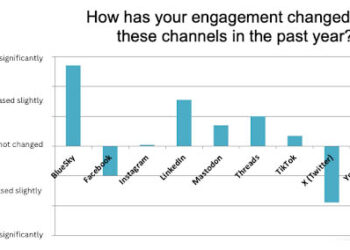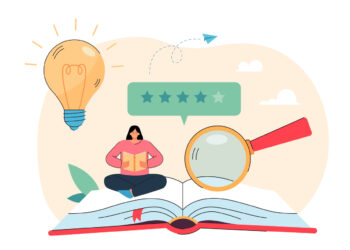
[Editor’s note: Chefs Rick Anderson and Joe Esposito have been studying patron-driven acquisitions (PDA) from opposite sides. Rick, a librarian, has been working with PDA as a way to improve the collection strategy at his institution. Joe, a publishing consultant, has been speculating about the impact of PDA on publishers. You can see some of Rick’s comments here, here, and here. Joe’s posts on the subject can be found here and here. As some of the Kitchen posts on PDA have elicited a number of comments, this dialogue may yield a sequel or two.]
Joe Esposito: What has surprised me about discussions of PDA to date is how controversial these programs are among librarians. Some librarians apparently view PDA as something that will undermine the integrity of library collections, while others see it as a useful tool for lowering costs and providing materials that their patrons will actually use. Do you see a way to reconcile this argument?
Rick Anderson: Maybe, although I think it’s worth pointing out that those three propositions are not mutually exclusive: PDA can, conceivably, simultaneously undermine the integrity of the traditional collection, help the library realize cost savings, and give patrons better access to the materials they need. One thing that leads librarians to respond negatively to PDA, I think, is the assumption that the library’s collection is an end in itself. If your goal is to build a great collection, then PDA is clearly no way to go about it. If, however, your goal in building a collection has been to give your researchers access to the materials they need in order to do their scholarly work, then PDA may be a better strategy than traditional collection-building. The bottom line, I think, is that each library needs to decide what problem it’s trying to solve with PDA. This suggests a need to decide what the “A” in PDA will stand for in your library: if you want to build a better collection, then you probably want to do patron-driven acquisition, and PDA is likely going to play a relatively peripheral role in your collection-building strategies. If you want to make the collection itself less of an issue, and instead focus on giving your researchers dynamic and real-time access to relevant and useful content, then your focus should be on patron-driven access, only some (if any) of which will result in the acquisition of permanent access rights. These aren’t mutually exclusive strategies, but it does matter where you focus your money and energy.
Joe: So it’s really not a binary thing: this way or that way, with nothing in between. I anticipate that as PDA grows (as I believe it will), we will find different libraries using PDA in different ways. There will be a continuum: at one end will be those libraries, perhaps the largest of libraries, where PDA plays a small role, at the other end, perhaps the smaller libraries, where PDA is at the center of a library’s strategy for acquiring books. There will be other factors besides size, of course; for example, a large library may use PDA in a particular area that the library views as nonstrategic for whatever reason. PDA would appear to be a customizable tool, not an all-emcompassing solution.
Rick: Yes, I think that’s right. We need to avoid the easy assumption that all research libraries are fundamentally the same. There are some (very few) that are charged, funded, and housed in such a way that they can both build and care for truly monumental, functionally comprehensive scholarly collections. As you suggest, these libraries are less likely to have much need for patron-driven programs because they can pretty effectively meet the needs of their patrons by preemptive purchasing; the speculative nature of traditional collection-building is less of a problem for them because the collection is meant to be a cultural monument, not just a tool for researchers, and if a significant percentage of the books they purchase don’t get used in the foreseeable future, that’s okay. At the other end of the spectrum are the much smaller research collections that are not intended to act as comprehensive records of our culture’s intellectual patrimony, but which instead serve almost exclusively to meet the real-time needs of real-time scholarship. These libraries are (and should be) under much more pressure to deliver content that is directly useful to today’s researchers, today. But these libraries have historically collected according to the same general strategies (on a necessarily smaller scale) as the comprehensive ones — not because those strategies made much sense for them, but because a more dynamic approach just wasn’t feasible; instant access was impossible in the print era. These are the libraries whose patrons stand to benefit the most from a more complete shift towards patron-driven access. In between those two extremes is a very broad and highly varied spectrum of research libraries whose needs and resources cover a wide range. All of these libraries, I contend, would benefit from looking seriously at patron-driven models and figuring out to what degree one or more of those models would work well for their patrons.
That said, I think it’s important not to underestimate the fundamentally disruptive nature of any patron-driven acquisition or access plan. To the degree that any research library adopts such a plan, it is in fact displacing a role that librarians have always considered central to their jobs. This is one of the main reasons PDA is so controversial in libraries, I think. It really does amount to an abdication of pretty foundational librarian tasks.
Joe: PDA (whether we mean patron-driven acquisitions or patron-driven access) is disruptive not only to the culture and processes of libraries but also to the publishers who hope to sell their books to libraries. In its crudest form, PDA will reduce sales (all those books that never circulate will now not be purchased) and delay the timing of sales for books that patrons request. It may be that the feedback from PDA will come to influence editorial policies; whether for the good or bad remains to be seen. A potential offset to this bad news for publishers is that library catalogues where PDA is used will be much more extensive, potentially serving as a means of discovery for books. So it’s possible to theorize that over time, PDA may actually help to sell more books. I am using “sell” here generically, to refer to any exchange of money, whether an outright sale or a lease of some kind.
Rick: Yes, I think that’s absolutely right. Scholarly publishers have always been able to rely on libraries to buy books based on their quality and their relevance to the library’s academic mission. By so doing, libraries built solid, high-quality collections and made it possible for many presses to publish and sell high-quality books that were of marginal interest to the research community. However, significant portions of the resulting collections were never used — partly because the books were of marginal interest (despite their quality) and partly because the relevance of a book to an academic discipline is no guarantee that it will be relevant and useful to any specific researcher. To the degree that a library shifts focus from collection comprehensiveness and quality to actual use by patrons, publishers who relied on traditional collecting will suffer, at least in the short term. In the long term they may benefit from libraries’ increased ability to give patrons access to the long tail of low-readership books — the question is how many of these publishers are equipped to wait out the short term. (Those with the deepest and most fully-digitized backlists are probably best positioned for survival, I think.)
This reality raises very difficult but fairly urgent questions about the degree to which libraries ought to play a supporting role for scholarly publishers, especially university presses. How should libraries balance their obligation to meet the real-time needs of scholars with their role as participants in a delicately-balanced ecology of scholarship that includes publishers? Sandy Thatcher, in the SK comment forum and several other outlets as well, has raised these questions thoughtfully, and although I’ve offered answers to them I think the questions are still open.
Joe: There is another scenario for publishers. If a library wants to use a PDA program for print books, there is nothing a publisher can do to stop it, as once the book is sold to a wholesaler, the publisher has no control on how the book ultimately shows up at a library. But if we are talking about ebooks, every transaction requires a license. A publisher could simply not permit its ebooks to be made available for PDA. PDA, in other words, is inherently a publishing program, not a distribution program. The possibility of controlling the flow of ebooks through licenses is a distinct possibility.
Rick: It is indeed. Another possibility would be for the publisher to allow PDA for its titles, but to charge high prices for books acquired that way and lower prices for books acquired in bulk (through approval plans, standing orders, etc.). That’s the model that journal publishers generally use; the unit price of an individual article is typically very high unless the library buys a subscription or a bundle of subscriptions. For books as for journal articles, that strategy will work to the degree that the publisher’s offerings are both unique (and therefore unsubstitutable) and in high demand (and therefore indispensable). Scholarly books do tend to be unique, but it will be interesting to see how many of them are considered indispensable by actual readers who are trying to accomplish scholarly tasks, as opposed to librarians who are trying to build high-quality collections.
Discussion
18 Thoughts on "A Dialogue on Patron-Driven Acquisitions"
With respect to how publishers will use PDA, I have heard that some university presses are particularly concerned about having books that potentially can be adopted for courses included not only in PDA programs but also in the licensed aggregates from Project Muse, JSTOR, etc. The trick, of course, is to be able to predict with any real confidence just which those books will be that succeed best in the classroom. Beyond a small number of pretty obvious candidates, there is a lot of room here for guesswork, and it will be interesting to see how many publishers withhold books from these modes of distribution and how many titles they keep out for potential course use as paperbacks. A lot of revenue for presses is at stake here, and these decisions will be among the most strategically critical that presses will be making in the years to come.
At some later point, I also wonder how much the DPLA will succeed in meeting the majority of needs that PDA (as access) will be meeting in the short term? The DPLA has potential to further disrupt traditional academic librarian roles.
Responding to Sandy:–Joe and Rick require another response all together…
I don’t think course based titles are an either or situation. Look, there’s a lot of work that could be done differentiating products, that as far as I can tell, is not happening. If a book is for single use only, its not suitable for course adoption. period. I have to explain this fact of ebook life regularly to faculty. IF we need an ebook for course adoption, why wouldn’t a book with characteristics like student and faculty note taking and annotation, linking to other content, group use (small groups are the norm in many classes now), cut and paste, automatic footnoting, the list goes on and on-links to video that the instructor imbeds for the course, etc.. That “version” of the book could be sold for a premium to the institution, or perhaps the institution charges individual students for the title for the specific course as part of their tuition or the bookstore gets in the picture, or the library licenses these new products for multiple uses? All i hear from university press reps is fear and more fear rather than opportunity to meet new needs. Get creative with products we need, and the revenue models will follow. We are at the cusp of a revolution, and I think there are too many publishers who still think they are making buggy whips.
Chuck Hamaker
If a book is for single use only, its not suitable for course adoption. period. I have to explain this fact of ebook life regularly to faculty.
Chuck, I’m curious — what do you mean by “a book for single use only”? I assume you must be talking about an ebook, so do you mean a book that can be used by only one student at a time?
Second question: why do you feel that it’s your place to tell a professor which books are and aren’t suitable for course adoption? I would imagine that a professor makes that decision based primarily on the content of the book, regardless of whether the access model is ideal. (After all, the access model for a printed book is pretty awful — each student has to buy his or her own copy; each copy can be used only by one student at a time; etc. — would you tell a professor that a print-only book is unsuitable for course adoption?)
I don’t think I’m suggesting I tell a professor what books to put on reserve. I’d like to help them be able to get it on reserves. I have told several professors that a single ebook with a single user doesn’t work for reserves. They normally assume that if we have an ebook its as available as it would be if on regular reserves. They don’t realize we don’t have that right, i.e. reserves with most commercial and university press ebooks is not a right we have. So yes, I do advise professors that ebooks don’t work for what they want out of a title on reserves. As as far as a single use only ebook, of the 250,000 e book titles we have, for the ones people want to use as reserve– they can’t as one student can “check out” the book and then the students and professor ask why the rest of the class can’t read the book. Many ebook providers don’t have an ebook reserve system, I can’t literally put an ebook on reserve most of the time. Is your experience different?
regards
Chuck
Chuck, I think you vastly underestimate how difficult it is to predict which books will succeed as course adoption texts. If you had told me in 1979 when we published a revised dissertation called “Dependent Development”–a single-country case study of Brazil–at Princeton University Press that it would go on to sell over 20,000 copies for course use, I would have said you were crazy, but thast is indeed what happened. I can cite many similar examples–and also examples of books that seemed like sure sellers but failed.
Sandy:
Why not have a reserves option for when a book is requested for reserve use? That is, the provider has an “upgrade” or “temporary upgrade” option when the library is notified a chapter of a book or the whole book is required reading? I’m not talking about when the professor requires the book of everyone taking the course, but the normal everyday title that libraries buy thousands of every year?
Just wondering why we can’t get both options. I don’t want a surprise payment required at the end of the year if the title is used more than predicted which is what some models are suggesting right now. I can’t budget that way. But if the request for a library to provide a copy for reserves is made, then that could trigger a “special arrangement” with the provider, depending on what is needed, i.e. a chapter or two or the whole book. I think models have to be flexible enough to meet both the publisher’s and libraries’ needs. I served on the review board for the LSU press for a few terms back in the 90’s and agree that predictions of what would sell how many copies were very difficult to make. Right now, I can’t put an eBook (chapter) on reserves for an hour or two because 30 students need to read one chapter for an assignment the next to last week of the semester. I think eBooks should be more flexible, not less, than the print version. Right now we have it the opposite way. Having the print version scanned for reserves is ok? Having the e version for temporary multiple use is more difficult for many eBook systems. And true multi-user fully annotation ready ebooks or chapters for academic library use don’t seem to be in the cards right now.
Regards
Chuck
The new Project Muse UPCC subscription does permit multiple simultaneous access to ebooks in its system.
Chuck, you’ve raised some very interesting issues in response to this post about PDA. Two in particular of note, I think. Are you suggesting that book publishers might profit from offering differentiated pricing models based on the amount of use allowed (or number of potential users) as has evolved in the journals world? And when you mention inability to put ebooks into library ereserve systems, is this something you run into more with the aggregated ebook vendors rather than publishers offering their own ebook platforms? Or do you see it broadly across both?
If simultaneous multiple access is permitted, what difference does it make whether an ebook is part of a library reserves system or not? All that a teacher needs to do is to put the URL for the ebook in the course3 syllabus and everyone in the class can use it.
Janet:
A few aggregators as Sandy mentioned, do not have limits on use. But as far as I can tell that’s the exception. I understand from talking with providers working with publishers that publishers are concerned that a title might get a lot of use, gutting what might be textbook sales. I’m suggesting there are other models we could use-other than the one which goes something like, if you use it more I’ll charge you more after the sale! We have a little notice on most reserves, and a lot of ebook providers won’t permit more than say 10 pages of printing, or restrict copy and paste functions, making ebooks for libraries less usable than for other customers. I’m suggesting we should be able to use them in a variety of ways and that separate payment schemes and functionality might be one way to go. Also, as ebooks don’t use standard linking schemes, (like the DOI) so we can’t link to the individual chapter in some systems.
Rick.
My apologies. I didn’t say what I meant clearly.
Chuck
I wonder how PDA may affect the larger scholarly enterprise over time, assuming PDA takes off as seems likely. Conceivably, the research agenda will come to more accurately reflect the actual interest of researchers and others–funding bodies, government agencies, commercial enterprises–in different research questions and indeed in whole disciplines, something that could be seen as a nice refinement or a dangerous distortion of the larger research agenda, depending on one’s point of view. On the whole, I think such an outcome would be beneficial, helping to apportion scholarly resources more economically and so helping to achieve desired ends more expeditiously. Of course, perhaps the future won’t be what we envision at all.
The library does not want to tell faculty which titles to use, still traditionally if a faculty member requested a resource that would not fit the library budget, it was not purchased.
One example of library financial concerns conflicting with faculty concerns would be if a faculty member wanted an eBook for a large class, such as 200 students. When I make these purchases, I decide on different models to purchase from, and sometimes the only multiuser model available is the one known as Non-Linear Lending; it allows 325 loans each 12 month period, yet it does allow concurrent access. Within a week’s time, 325 loans could be used up by such a class.
If the eBook was $50, and the students used the title regularly, the costs could easily add up at $200 a month for one title. So if an eBook was not available with any other loan models, the library may need to develop their collection policy to include procedures for these purchases.



